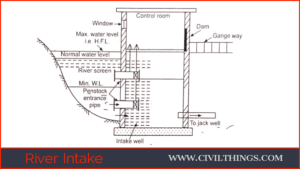Water intake structures are important because they play a crucial role in ensuring the availability and accessibility of clean water for various purposes. These structures are designed to collect water from rivers, lakes, or other sources and supply it to treatment plants, reservoirs, or distribution networks. They regulate the flow of water, prevent sedimentation and debris from entering the system, and protect the quality of the water. Additionally, intake structures also help in maintaining the ecological balance of aquatic ecosystems.
TYPES OF WATER INTAKE STRUCTURES
Intake Structures:
- Intakes are architectural elements primarily comprising open gratings or strainers that allow the passage of untreated water from rivers or canals.
- These intakes facilitate the flow of water to a collection well through conduits.
- Water is then pumped to the treatment plant through rising mains.
- Intakes are used to collect water from various sources.
- Following are the various types of Intakes :
(a) Canal Intakes,
(b)Reservoirs Intakes,
(c) Lake Intakes,
(d) River Intakes.
(A)Canal Intakes:
- As the water level in the canal remains more or less constant, there is no need of providing pipes at various levels. Figure show canal intake.

- A canal intake typically comprises a pipe embedded within a brick masonry chamber that is partially built into the canal’s embankment.
- On one side of the chamber, an opening is provided with a coarse screen for the entrance of water.
- The chamber housing the pipe is equipped with a flared entrance and a hemispheric fine screen at its end.
- From there, the outlet pipe transports the water to the opposite side of the canal bank, where it is then directed to treatment facilities
(B)Reservoir Intake:
- A river’s flow can be harnessed and transformed into a reservoir through the construction of a dam or weir.
- Intake pipes are strategically positioned at various levels within the reservoir to accommodate the fluctuating water levels, regardless of whether the dam in question is constructed as an earthen, masonry, or concrete structure.

- The figure shows the Reservoir intake mostly used to draw the water from the earthen dam reservoir.
- To regulate the flow of water, a carefully positioned intake tower is built along the slope of the dam, equipped with screens that effectively filter the water entering through the intake pipes.
- The water flow is effectively managed through the utilization of sluice valves.
(C) Lake Intakes :
- For obtaining water from lakes, mostly submersible intakes are used.
- Within the lake’s bed, the intakes are meticulously crafted, comprising a pipe with a bell-shaped opening that is shielded by either a timber or concrete crib structure.
- Water flows from the opening and is collected in a sump well and then pumped to the treatment plants.
- These intakes are cheap in construction. The figure shows Lake intake.

(D)River Intakes:
- It is a circular masonry tower 4 to 7 m in diameter.
- The structure is erected alongside the riverbank, strategically positioned to enable the extraction of water in the desired quantity.
- The various river intakes are wet intake, dry intake, and movable intake. Figure Show River intake.
- Since it is located on the banks of the river it is called shore intake.

Factors Governing the Location of Intake Structure:
The following factors are to be kept in mind while locating the intake structures:
- At the site, there should not be heavy currents of water which might endanger the safety of the intake works.
- The site of intake should be easily approachable. (c) Intakes should draw a sufficient quantity of water.
- The best quality of water should be available near the intake.
- Intake must be placed near the treatment plant.
- Intakes must not be located in the vicinity of the point of sewage disposal.
- The site should remain easily accessible during floods and should not get flooded.
- The site should provide the best quality of water to minimize the cost of purification.
Also Read,
1.SOURCES OF WATER | ENVIRONMENTAL ENGINEERING | NOTES
2.AIR POLLUTION – ENVIRONMENTAL ENGINEERING | NOTES
3.TOWN AND COUNTRY PLANNING: INTRODUCTION AND NOTES
4.WHAT IS FILTRATION | THEORY OF FILTRATION

Hi! I’m Sandip, a civil engineer who loves sharing about Civil Engineering & new ideas and tips. My blog helps you learn about engineering in a fun and easy way!


Comments are closed.